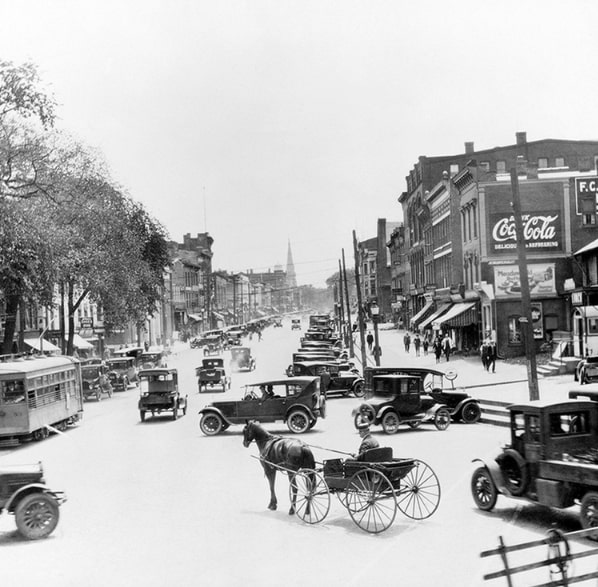Introduction: In this article, Gena Philibert-Ortega explains how a one-place study can broaden your genealogy – and she provides many helpful links. Gena is a genealogist and author of the book “From the Family Kitchen.”
Genealogists and family historians trace their family lineage. But the way you decide to trace that history can differ according to what you want to know. Depending on your research question or curiosity, you might want to narrow your focus on a location, whether it be where your ancestor lived, frequented, or died. That’s where a one-place study can help.

What Is a One-Place Study?
According to the Society for One-Place Studies:
“A One-Place Study considers people and families in their physical and social context in any location across the globe. This could cover any area including a town, village, suburb, estate, a single street, or even an individual building.” (1)
What this means is that you can choose to study and learn more about a variety of places, whether it’s a single building, a workplace, a neighborhood, or a city.
So, now you may be wondering: why? Tracing your family may take up enough of your time, why would you research a place in addition to your family? In general, you can learn more about your ancestor by learning about their place. A historical look at where they called home can help you understand their FAN Club (Friends, Associates, and Neighbors), what records exist, and what events impacted them. A one-place study is one way of conducting cluster genealogy, which looks at an ancestor or ancestral family’s community.
What can you study if you decide to take on a one-place study? You can research your ancestor’s building, street, neighborhood, school, or church community. But there are also other examples that might be of interest. Looking at what other researchers have done may give you some ideas for your own study.
- Kara Mae Harris of the website Old Line Plate studies communities from cookbooks and recipes, including the winners of the 1911 Baltimore Sun recipe contest. She learned more about the participants and plotted their addresses on a map.
- Pine Mountain Settlement School, Harlan, Kentucky, One-Place Study. “The Pine Mountain Settlement School One-Place Study was created in collaboration with the One-Place Studies Project, the Kentucky Project and the Appalachia Project as part of an ongoing effort to highlight significant places in Appalachia. The study focuses on documenting and connecting people associated with the school.”
- Peek Home Orphanage, Polo, Illinois, One-Place Study researches the residents and staff of the orphanage.
What Records Do You Use for a One-Place Study?
One-place studies use many of the same records that we use in researching our families. In a one-place study you are researching a community – and with that you’ll want to learn more about the people in that community. Records to identify the community and community members include:
- Censuses
- City Directories
- Tax Lists
- Maps
- Historical Newspapers
- Histories
Instead of just documenting your family in these records, you would identify all community members. Spreadsheets can be used to keep track of community members and what you find in each record. A map can also help you visually document who lives where.
Places to Learn More
Genealogists join genealogy societies to learn more about research. The same is true for societies that focus on a type of research, such as the Society for One-Place Studies. Joining this society can provide educational benefits and access to a like-minded community that can help you begin your study and is available to answer questions.
You can look for other one-place studies by searching or browsing the One-Place Studies Directory. Studies can be viewed by country. According to the website, the studies included cover:
- “Whole Community Studies – usually a whole village/parish or town/township;
- Cemetery Studies – usually a whole cemetery, churchyard, or graveyard;
- Disaster Studies – studies that can be tied to a single location on land, such as mining disasters;
- Single Property Studies – usually a house, farmstead, or an institution such as an orphanage or workhouse;
- Single Street Studies – usually a whole road, street, or terrace of properties;
- War Studies – usually focused on those listed on a war memorial who died, but sometimes expanded to include others who served and survived.” (2)
Over 3,000 one-place studies can be found here. Each study includes a link to the website where more information can be found.
The free collaborative tree website WikiTree has a One-Place Study Project. Why does a family tree website have pages for one-place studies? According to their One-Place Studies homepage:
“Our Mission is to support and guide those who choose to do these studies. To promote connections of families and their ultimate connection to our Global tree.”
Some of these studies are linked to the One-Place Studies Directory. One example you can find is the page for the Freemont Cemetery One-Place Study.
One-Place Studies & Genealogy
Genealogy is the study of families, but it can include much more than just tracing the people we share a genetic tie with. A one-place study can assist you in understanding their place in time, their community, and historical context. Take a look at one-place study resources to get ideas how this research can help you with your family history.
Explore over 330 years of newspapers and historical records in GenealogyBank. Discover your family story! Start a 7-Day Free Trial
_______________
(1) “Home,” One-Place Studies (https://www.one-place-studies.org/: accessed 5 September 2023).
(2) “The Directory,” One Places Studies Directory (https://oneplacestudy.org/: accessed 5 September 2023).
